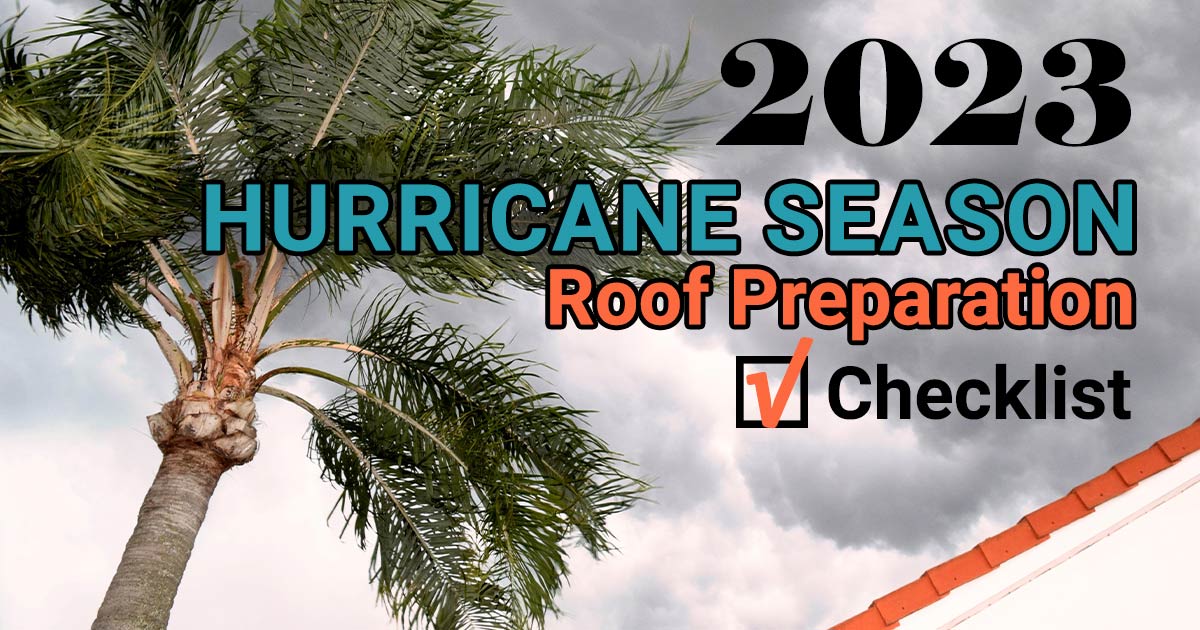2023 Hurricane Season Roof Preparations
Published: 08/18/23

The 2023 hurricane season is set to be a tough one. While initial predictions described an average season, updated models are showing that the Atlantic has a lot more in store.
According to the National Oceanic and Atmospheric Administration (NOAA), the predictions for the 2023 hurricane season have been updated from "near normal" to "above normal." They anticipate 14-21 named storms, with six to eleven of those developing into full hurricanes.
With such predictions, homeowners in South Florida must take proactive measures to safeguard their homes, especially their rooftops. Below, we’ve provided a checklist to help you address all of the essentials.
Hurricane Season Roof Preparation Checklist
- Roof Inspection:
Having your roof inspected by a professional is the first step to guaranteeing your roof is strong enough to survive the season. Aside from loose shingles, cracks, and other obvious signs of wear and tear, a qualified contractor will be able to identify problems that aren’t obvious to the untrained eye. They’ll also be able to prescribe solutions that properly address the issues. - Secure Loose Objects:
With powerful winds flying through, any loose objects or debris on the roof can become potential projectiles during a hurricane. Clean your gutters, secure satellite dishes, and remove any loose items. Now is also the time to remove or secure lawn decor, potted plants, gardening equipment, patio furnishings, and other objects that could potentially be lifted onto your roof. Don’t underestimate the strength of a hurricane! - Install More Roof Straps:
Despite how it sounds, these aren’t just ropes tied onto your roof. Hurricane roof straps (or “ties”) are actually metal brackets that are added to reinforce the joints in your roof’s frame. These robust pieces of hardware can help hold your roof down during strong winds, drawing strength from the rest of your home’s structure. While Florida’s building code requires homes to be built with these straps, many only meet the minimum requirements. Consider having your roof straps reinforced where possible, and adding ones to joints where they are absent. - Reinforce Your Roof:
Consider adding a secondary water barrier to your roof to prevent water intrusion. This barrier can be beneficial if your roof covering is torn during the storm. Such an investment can save you from costly water damages. - Check Your Insurance: Having homeowner’s insurance doesn’t guarantee that all damages will be covered. Check that your homeowner's insurance covers hurricane-related roof damages, and what stipulations are in place. It's also a good idea to document the current state of your roof with photos. This can be helpful for insurance claims after a storm.
- Trim Trees:
Overhanging branches can damage your roof during a hurricane, either by scraping the surface or falling onto it. It’s even possible for branches to penetrate your roof’s exterior. You can prevent this by trimming any branches that are too close to your home. Experts generally recommend trimming branches to be at least 10 feet away from your rooftop. - Consider Roof Upgrades:
If your roof is old or has sustained damage in the past, consider upgrading to a more hurricane-resistant design or material. Metal, tiles, and GAF Timberline shingles are all popular choices in South Florida for their excellent wind resistance.
AKVM Can Help Secure Your Rooftop ASAP
With the peak of hurricane season just around the corner, there’s no time to waste. It’s critical to make the right preparations now to ensure your home is safe and ready once the first storms hit.
AKVM’s team of roofing specialists can assist you with diagnosing and treating any problems your roof has before they become a bigger threat. Contact us to get a FREE inspection and estimate.
REQUEST A
FREE ESTIMATE

See What Our Customers Are Saying
Recent Posts
Choosing A Multi-residential Roofer
Choosing The Best Roofer
Energy Efficient Roofing Solutions
How Long Does It Take To Replace A Roof?
Debunking 10 Common Roofing Myths
2025 Roofing Tech & Trends
How To Choose Color For Tile Roof
What Is Drip Edge?
What Do Roof Vents & Penetrations Do?
How Roofs Impact Market Value